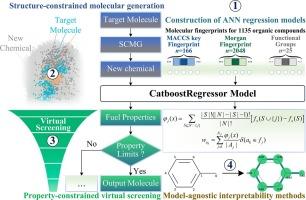Explainable machine learning assisted design of tailor-made fuels using conjoint fingerprints
IF 9.9
1区 工程技术
Q1 ENERGY & FUELS
引用次数: 0
Abstract
This work presents an advanced computer-aided molecular design framework by considering the molecular structure of fuels as the fundamental design degree of freedom. Initially, machine learning algorithms were trained with conjoint fingerprints along with extended connectivity fingerprints, molecular access system keys and functional groups fingerprint separately. Conjoint fingerprints demonstrated the highest predictive accuracy, with R2 values generally exceeding 0.9 for physicochemical properties. Subsequently, a novel structure-constrained molecular generator was introduced to systematically generate chemical structures by exploring all rule-based possible isomers of a given target molecule, aiming to produce high-performance fuels. Computational property prediction was employed to virtually screen the generated structures against desired physicochemical fuel property constraints. Finally, explainable artificial intelligence techniques were then applied to achieve atomic-level visualization and quantitative analysis by overlaying the target molecular structure with the atomic contribution values gained for specific properties, providing detailed insights that improve the understanding of how fuel molecular structures affect properties and aid in designing new molecules compared to traditional qualitative analysis. Two case studies were dedicated to illustrating the framework for (i) molecular generation tailored for compression-ignition engines and (ii) analyzing cetane number attributions based on atomic contributions.

利用联合指纹进行可解释的机器学习辅助定制燃料设计
本研究提出了一种先进的计算机辅助分子设计框架,将燃料的分子结构视为基本的设计自由度。最初,机器学习算法分别使用联合指纹、扩展连接指纹、分子访问系统密钥和官能团指纹进行训练。联合指纹的预测准确率最高,理化性质的 R2 值一般超过 0.9。随后,引入了一种新型结构约束分子生成器,通过探索给定目标分子的所有基于规则的可能异构体,系统地生成化学结构,旨在生产高性能燃料。利用计算性质预测,根据所需的燃料理化性质约束条件对生成的结构进行虚拟筛选。最后,应用可解释人工智能技术,通过将目标分子结构与特定属性的原子贡献值进行叠加,实现原子级可视化和定量分析,与传统的定性分析相比,提供了详细的见解,提高了对燃料分子结构如何影响属性的理解,有助于设计新分子。两个案例研究专门说明了(i)为压燃式发动机量身定制的分子生成框架和(ii)基于原子贡献分析十六烷值属性的框架。
本文章由计算机程序翻译,如有差异,请以英文原文为准。
求助全文
约1分钟内获得全文
求助全文
来源期刊

Energy Conversion and Management
工程技术-力学
CiteScore
19.00
自引率
11.50%
发文量
1304
审稿时长
17 days
期刊介绍:
The journal Energy Conversion and Management provides a forum for publishing original contributions and comprehensive technical review articles of interdisciplinary and original research on all important energy topics.
The topics considered include energy generation, utilization, conversion, storage, transmission, conservation, management and sustainability. These topics typically involve various types of energy such as mechanical, thermal, nuclear, chemical, electromagnetic, magnetic and electric. These energy types cover all known energy resources, including renewable resources (e.g., solar, bio, hydro, wind, geothermal and ocean energy), fossil fuels and nuclear resources.
 求助内容:
求助内容: 应助结果提醒方式:
应助结果提醒方式:


